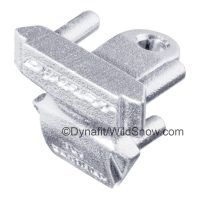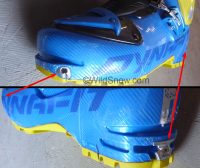Part 1, Toe Fittings
Part 3, Manufacturing
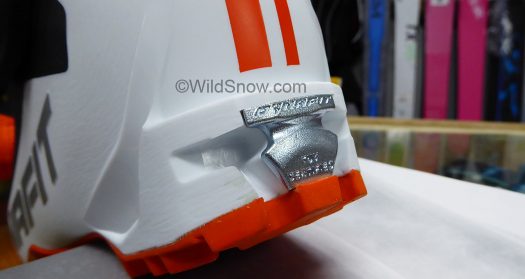
Master Step heel is a significant improvement to the three decade run the “standard” boot heel tech fitting has enjoyed.
Compared to the brain swelling complexity of “tech” toe fittings used in ski touring boots (stay tuned for additional reports, making them isn’t easy), heel fittings haven’t been through much evolution until recently. We like the new Master Step version as it appears to enjoy a steroid enhanced connection to the boot. But the earlier “standard” heel fittings, properly maintained, did fine for millions of skiers over decades of use (with exceptions we mention below). Herein, the basics for those of you new to ski touring gear: we report on what Dynafit will be supplying for tech heel boot fittings, 2017 and onward. (Please note this post was made possible by Dynafit financial support, while we retain 100% editorial control.)
 Historical note: Other than very early prototypes, the original retail Low Tech heel fittings invented by Fritz Barthel we’re virtually the same thing as what’s presently the “Standard” fitting. This is the steel lug you’ll find embedded in the heels of literally millions of ski touring boots manufactured over the past thirty years. Considering its minimal attachment (small screw and a couple of pins pressed into holes) it was amazing how few people experienced failure of this part.
Historical note: Other than very early prototypes, the original retail Low Tech heel fittings invented by Fritz Barthel we’re virtually the same thing as what’s presently the “Standard” fitting. This is the steel lug you’ll find embedded in the heels of literally millions of ski touring boots manufactured over the past thirty years. Considering its minimal attachment (small screw and a couple of pins pressed into holes) it was amazing how few people experienced failure of this part.
Nonetheless, the fitting coming off the boot heel has not been an unknown occurrence. This especially so for ski mountaineers who spend time off skis, hiking in rough rocky terrain where the fitting can be pried or otherwise peeled as if attacked by tiny destructo-gremlins hiding in the rocks. (Yes Virginia, gremlins exist, if you have standard tech fittings and use your boots hard, we continue to recommend yearly maintenance).
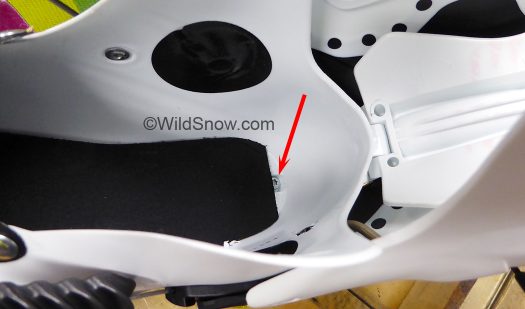
Masterstep fittings are held with a screw inside the boot, as well as pins that press into the boot shell.
The standard rear fittings always worked for us — but the new ones are looking super nice. Both the Master Step and Master Step Light “bolt” into the boot internally. That’s a much better configuration than the sometimes fragile, single tiny screw of the standard fitting. Further, the full Master Step fitting boasts four anchor prongs. Fair to say it’s “twice as strong,” as Dynafit states. (We experimented some time ago with retrofitting a through-bolt for the heel fitting, was interesting.)
The added strength of Master Step is particularly important for the “free touring” segment of the sport, as aggressive skiing by strong athletes can demand binding retention settings that verge on astronomical — sometimes providing a max setting of “DIN” 16. That corresponds to 160 Nm torque, or 118 foot pounds. That’s equivalent of applying 118 pounds of your body weight to a 1 foot long pry bar. (Note, the regular Master Step fitting (not the light version) is also said by Dynafit to “step into the Beast 14 and 16 bindings _without_ a Power Insert heel adapter.)Clearly, Master Step fittings will hold you in. On the other hand, it’s worth mentioning that in terms of release and retention, they perform exactly the same as the standard tech fitting. Read on.
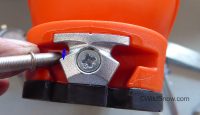
Vertical heel travel of a classic tech binding is dictated by how far the binding pins move down and out of the binding as your heel moves up — minimal distance as indicated by the arrow.

Power Insert heel adapter by Dynafit. A nice upgrade for aggressive skiers (works with any classic tech binding) but unnecessary if you use the regular version Master Step.
I mention the elasticity issue to be complete. It’s not a deal breaker for most skiers, and indeed a recent trend to “retro” type tech bindings (e.g. Dynafit Speedfit & TLT Speed) shows how wonderful the original system is. Indeed, for the most efficient human powered skiing, using the “classic” tech binding mechanics with two pins at the boot heel is what we continue to recommend. It’s how you’ll get the lightest and most efficient bindings under your feet. At least for now. In a few years, who knows?
Meanwhile, nice improvements on the Master Step fittings — especially the heel. If you’re interested in more backstory, check out this early prototype Low Tech (Dynafit) ski touring binding.
Sidebar: For readers new to ski touring, a photo review. Basic ski touring boot with tech fittings at toe and heel. Rear fitting here is a “standard,” used industry wide before Master Step. At the toe, a Quick Step In (QSI), identified by the small notch below the fitting socket. These are somewhat easier to step into, but not greatly so. Most of using tech bindings efficiently and gracefully is about practicing techniques for entry and exit. Most require a bit more “English” (or is that German?) than step-in type bindings that snap a clamp down on the heel of your boot.WildSnow.com publisher emeritus and founder Lou (Louis Dawson) has a 50+ years career in climbing, backcountry skiing and ski mountaineering. He was the first person in history to ski down all 54 Colorado 14,000-foot peaks, has authored numerous books about about backcountry skiing, and has skied from the summit of Denali in Alaska, North America’s highest mountain.

